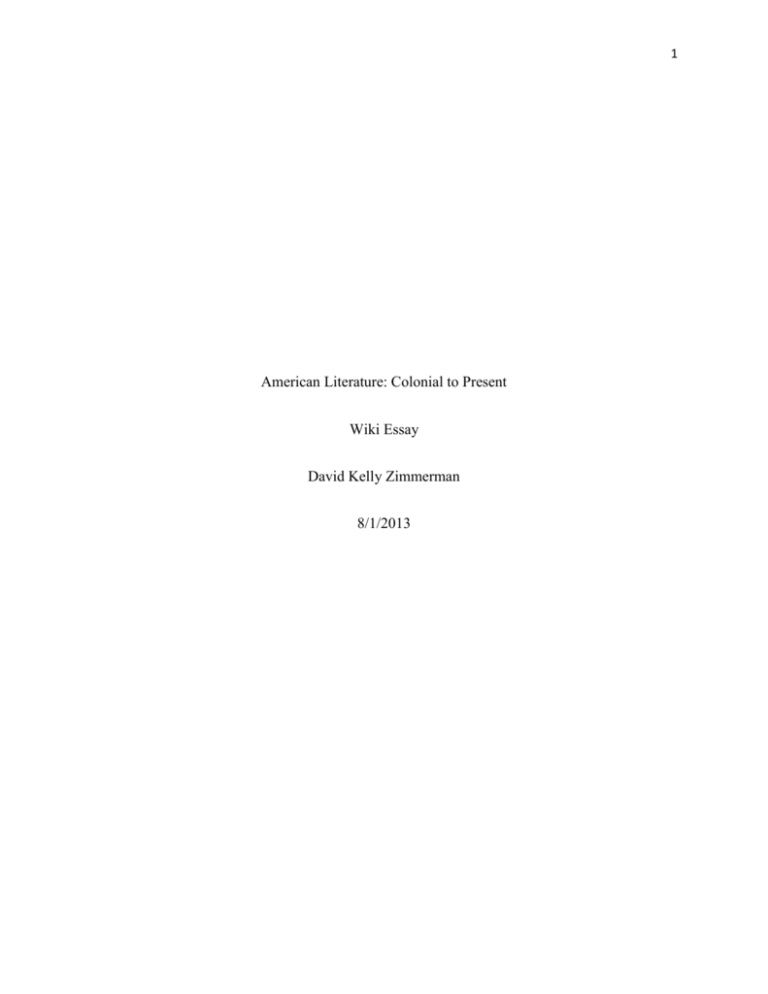Landscape
advertisement

1 American Literature: Colonial to Present Wiki Essay David Kelly Zimmerman 8/1/2013 2 Swedish-born author and philosopher, Alain de Botton said, “Sublime landscapes, through their grandeur and power, retain a symbolic role in bringing us to accept without bitterness or lamentation the obstacles that we cannot overcome and the events that we cannot make sense of”(1). What Botton suggests is that landscape lends itself to every experience, good or bad, and explains the parts of life that humans can’t. He also describes landscape as being “symbolic”, books written in the early part of the 20th century prove this as true. Works such as O Pioneers!, Anne of Green Gables, Edgar Huntly and Letters of An American Farmer all have vivid imagery that invokes a realistic feeling of the landscape and situation. The landscape is perceived as dark and dangerous, wild and foreboding, and even bountiful and beautiful, and bright and joyous. Landscape is one of the most abundant themes in American Literature, although it is perceived differently in the texts. One of the most prevalent perceived landscapes is that of the unknown or dangerous. In O Pioneers! By Willa Cather, we meet the Bergson family. They belong to part of the settlement in south central Nebraska in the late 1800s and early 1900s. The author describes the landscape as a “windy Nebraska table land” on top of which sets a “cluster of drab buildings huddles on the prairie, under a gray sky.”(2) The European settlers, hoping for a better life, took everything they had and moved to a new land. Only when they arrived, the dream of prosperity seemed to dwindle. The land proved to be much less willing to be tamed. The dark and drab world fought its new inhabitants, throwing vicious snow storms that ravaged their farms, froze livestock and even claimed lives of some settlers. The dark unknown countryside seemed unconquerable, they could never survive there. However, once they began to learn about the wild land, they started to become coexistent and understanding. On a trip home one day, Alexandria Bergson looked out on the scenery and thought, “There is something frank and joyous and young in the open face of 3 the country.” (3) The imagery and feel changed from a grey enemy to a bright friend. The dark and unknown theme is viewed differently in the book Edgar Huntly by Charles Brockden Brown. In this tale, the theme oscillates between light and dark, according to his emotions. Heroic Edgar Huntly is on a manhunt for the assassin of his good friend. On the search, he tracks the main “suspect” to a cave. While Huntly is contemplating further pursuing or not, Brown writes, “Was this person an assassin, who was acquainted with the windings of the grotto, and who would take advantage of the dark to execute his vengeance upon me, who had dared to pursue him to these forlorn retreats? or was he maniac, or walker in his sleep?” (4) In this instance the darkness was a symbol of his ultimate demise. There are also moments where the dark turns to light and the danger turns to safety, but not always so. Scenes such as the panther’s eyes and the Indian guards’ fire, were symbols for danger. The scenery was also painted as beautiful or sublime. Written in 1908 by Canadian author Lucy Maud Montgomery, Anne of Green Gables is the coming of age story of an orphan girl who is adopted by an older couple that lives on a big farm. There is an instance in the book where Anne faces leaving Green Gables because the couple though they wanted a boy. She woke up on her “last” day and took a look at the scenery. “Anne’s beauty-loving eyes lingered on it all, taking everything greedily in” she says, “She knelt there, lost to everything but the loveliness around her” (5). The land was the most sublime thing she had ever laid her eyes on, such so that it brought her to her knees. As aforementioned, Anne’s eyes craved beauty. If she would be forced to leave this wonderful place, it would starve her eyes, therein her soul. There was a large appearance of beauty in Crevecoeur’s Letters From an American Farmer. The beauty didn’t necessarily come from the land which was beautiful, rather, it came from the pride that the settlers gained by making their own country. There was the thought that a man could be no better 4 than where he lived. If they could make a new land, they could make different lives for themselves. Pride and the self image were everything to early American settlers. Crevecoeur wrote that the settlers were “all animated with the spirit of an industry, which is unfettered and unrestrained because each person works for himself.” (6) He felt that the country was created by the dream of a new life, and alive only because of their hard work. The authors all had different reasons for depicting the scenes as they did. For Crevecoeur, he wrote about hope. There were many people in European countries that needed to get out of their impoverished homelands. In 1780, Crevecoeur said that in America the rich and poor weren’t “so far removed from each other”, the dream to move up the status ladder could, finally, be realized. He depicted the New World as the place that will make the settlers rich and vice versa. He also provided the readers in Europe the push needed to attempt anything as crazy as leaving your life you know, and moving over the ocean, into the unknown. Anne of Green Gable was written to satisfy the author’s fascination with orphans and to tell the happy-ending story of a fictional girl. She pours in detail of emotion and imagery to convince the readers of authenticity. The scenery is a symbol of the new wonderful life that Anne was fortunate enough to come by. Edgar Huntly uses landscape, in accordance with emotion, to make the scenes complete. He wanted to reader to not only be immersed in the story, he wanted to make you live the characters story. The landscape is formed from Huntly and Clithero’s vantage points. Like an entire movie through the eyes of two men. The text is written in this way because Romanticism was the prevailing writing tone in that time (1799). It possessed a great emphasis on the emotions the characters were feeling rather than the information in the actual plot. As such, the protagonists faced many emotional dilemmas in the obstacles they traversed. From O Pioneers! it could be inferred that the landscape changes as the protagonist, Alexandria, changes from 5 young woman to elderly lady. The land in her early years was tough and cunning, much like Alexandria. She had to be tough in those times. The settlers who couldn’t be just that, were forced to leave and settle for their old lives. She was cunning in the way that she learned from other farmers how to grow better alfalfa. She learned the ways to bend the landscape to her will. The landscape makes her into a woman, and illustrates what it took to make it on that frontier. We have wonderful landscapes in America. On the small scale (i.e. cities, farmland), the landscape has changed drastically. The small homestead farms have now changed into massive commercial farms that span thousands of square miles. The small settlement towns have erupted into huge cities many miles long and even thousands of feet high. The large scale, however, hasn’t changed much at all. The mountains still hang higher than any skyscraper. The deserts range far greater than any bustling metropolitan area. And the plains stretch farther than any of our farmland can. Humans have changed the landscape to their needs, but we are hindered by the limitations of our technologies. As humankind strives for new frontiers and new things to conquer, the land only remains the constant. 6 Bibliography (1) De Botton, Alain. The Art of Travel. Penguin, 2003. Print. (2) Cather, Willa. "Part I/Chapter I." O Pioneers! 1. 1913. Print. (3) Cather, Willa. "Part III/Chapter I." O Pioneers! 1. 1913. Print (4) Brown, Charles B. "Chapter 2." Edgar Huntly. 1799. Print. (5) Montgomery, Lucy M. "Chapter 4." Anne of Green Gables. 1908. Print. (6) Crevecoeur, J. Hector St. John. Letters From an American Farmer. 1780. Print.










